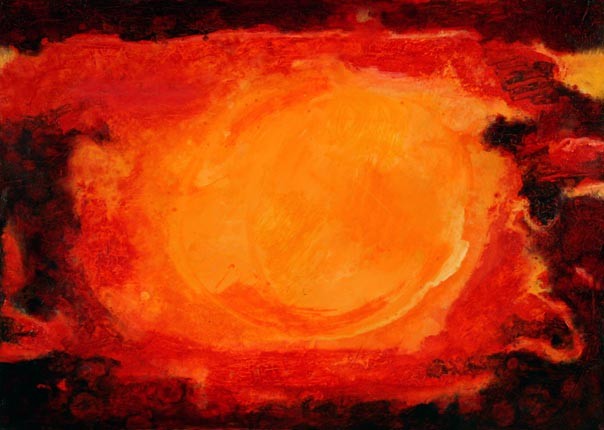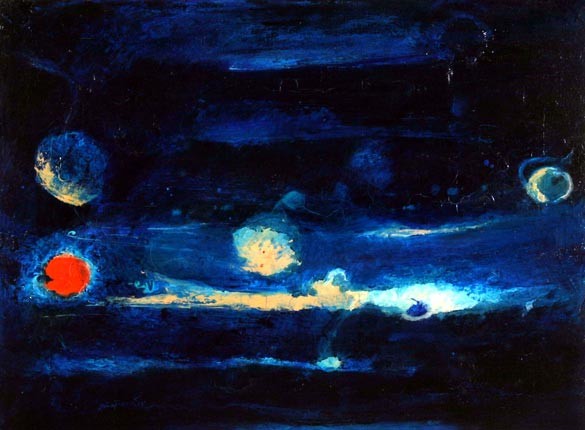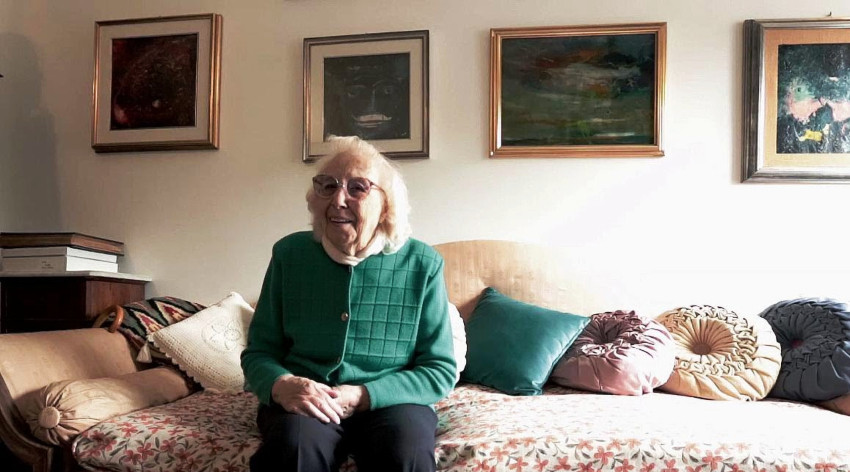White comets streak through the sky, planets emit a crimson glow, cloud decks spread out like powder puffs. Suddenly I set off on a journey into space. I witness the creation of the world. “It’s Iliya”, I hear an alto voice grounding me. The dream is over, but I am still staring at the pictures on the wall. The flat on the fourth floor in a quiet residential district in Rome is a place for art lovers. From there, as from a spaceport, they are launched into the vast. And somewhere among the stars, planets and galaxies they meet the soaring spirit of Ilia Peikov - the Bulgarian who saw the Cosmos before Gagarin.
“It was a beautiful red sunset over Vitosha Mountain. Ilia was staring at the sun until the least ray faded away. Something had changed in him in that extraordinary summer night.” We both seem to see the fiery light. Here, in the old housing cooperative in Rome, Iole Mancini takes me on a journey across the universe captured in her husband’s paintings.

In the beginning was the love for art. In the 1940’s it took Ilia Peikov to Rome, where his brother Assen had already made a career in art.
Born in 1911, the painter of planets, stars and suns stayed in the Eternal City for good. Years later, he was asked what he thought about death. "I am not afraid to die, I only regret leaving Rome". Ilia said.
In Italy, the young man found himself in the whirlwind of bohemian life he had never dreamt of in his native town of Sevlievo. At that time, Assen already had a studio on the coziest street in Rome- Via Margutta. He partied together with Vittorio De Sica, Federico Fellini, Ava Gardner, etc. It was on Via Margutta, the true and only home of artists, that Ilia Peikov first explored the sky with the curios eyes of an amateur artist.
“Ilia’s paintings resembled the images that were later transmitted from Space”, said Iole Mancini. The elderly lady pointed out to the canvases, densely packed in the corridor of the small flat. “They are all miracle of the human brain”. In Italy, Ilia is known as “the painter of Cosmos”, but in Bulgaria he is known only to the most ardent connoisseurs.

The oil paints are applied with fingers. The self-taught artist did not use any brushes, because he wanted to feel the canvas with his touch, Mrs Mancini recalls. However, his hands got infected after the long contact with the oil paints and he had to resort to the help of “an intermediary” between the mental images and the canvas. “Ilia liked to mix bright colors. Red was his favourite color”, Mrs Mancini went on to say.
Iole Mancini often stops by her husband’s studio.
“I would stop by in his studio, lean over his shoulder and ask him what he was painting. And he would say: “I don’t know. I will see what I can come up with.”. Several days later, he would get close to the final image. “Ilia would start to paint on several canvasses at the same time and each day he would layer the colors”, Iole Mancini recalled.

When Yuri Gagarin returned from his journey into outer space, he thought that he was the only human to have peered into the universe. However, Gagarin was awestruck when he stumbled upon Iliya’s space landscapes in Rome. “It is impossible to transfer what is really there onto the canvas”, Yuri Gagarin told the artist. Meanwhile, Stanley Kubrick’s film “2001: A Space Odyssey” was released and Ilya’s friends would ask him how come the images from his canvasses were exactly like those in the film.
“He thought that his imaginary pictures existed up there”, Mrs Mancini explained. –He didn’t have a telescope and could not take a glimpse of the objects he only saw in his imagination. However, according to the Vatican cardinal who visited one of his exhibitions, there was no miracle- Ilia is closer to God than any other believer. That is why he solved the mysteries of universe in his paintings.
"I painted the place where I will rest one day, when I will no longer be in this world," Ilia Peikov said shortly before he passed away. “The Valley of Silence” was painted in 1987, one year before Ilia’s death. Today, the painting is kept at the Order of Minims. The monks also keep other paintings, donated by the renowned Bulgarian artist.
Italy has not forgotten the artist who showed people that they are just a tiny speck in the infinite universe. In 2007, the Municipality of Rome agreed to name a square after Ilia Peikov. This space will always remind us of the Bulgarian artist whose cosmic paintings still adorn prestigious galleries and private collections around the world.
*The interview with Iole Mancini was made in 1999 in Rome.
Prof. Dr. Ivan Ivanov is known as Father Ivan or Padre Giovanni among the Bulgarians in Rome. The professor divides his time between Rome and Sofia. He is a lecturer at the Theological Faculty of the Sofia University and he also leads the services in the..
Writer Anna Maleshkova celebrated her 80th birthday at the end of 2023 - at a heartwarming meeting with like-minded friends at the State Archives in the capital. "I'm still looking forward, I still want to live, I love life, I..
He is 24 years old, originally from the Bulgarian town of Rakovski, he has spent most of his life in Italy. Stefan Borgodjiisky is currently a student at the Accademia Nazionale di Santa Cecilia in Rome, majoring in clarinet, but he is in love..

+359 2 9336 661
